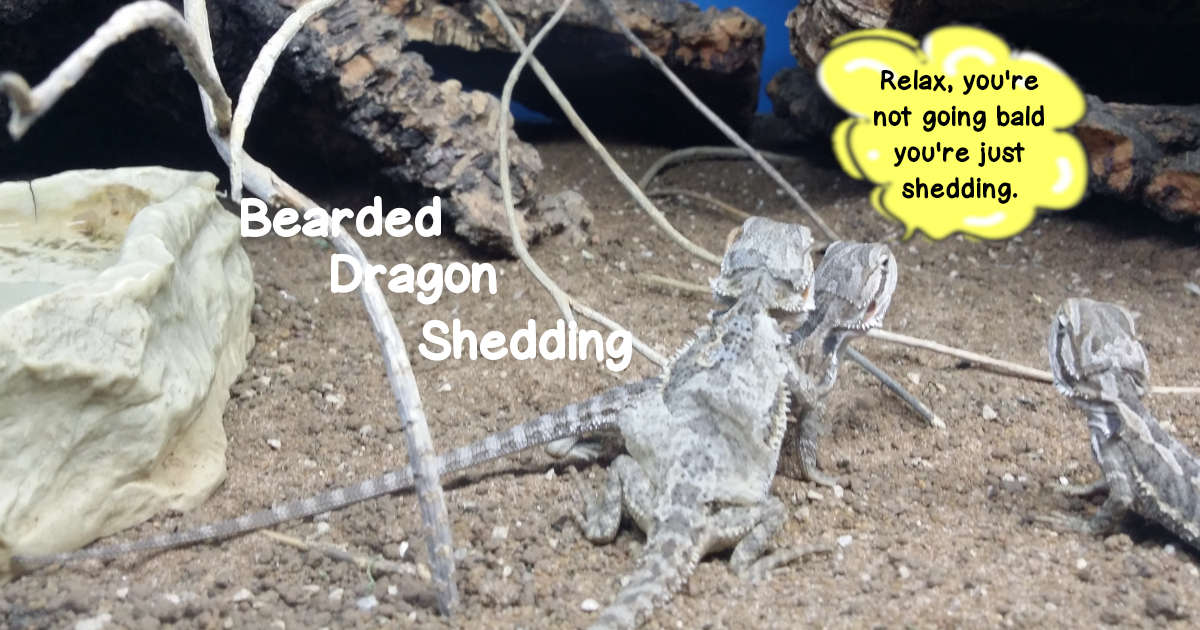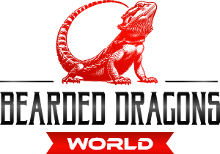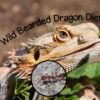The bearded dragon shedding process is scientifically known as ecdysis. Bearded dragons shed their skin periodically to accommodate growth and maintain their health. This natural process can be a straightforward affair but sometimes may present challenges.
The frequency of bearded dragons shedding largely depends on their age and growth rate. Young and rapidly growing bearded dragons may experience more frequent shedding, sometimes as often as every few weeks. Adults tend to shed less regularly, often every few months or as needed. While shedding is a normal and healthy part of a bearded dragon’s life, various environmental and health-related factors can influence the overall shedding process.

Jump To…
Key Takeaways
- Bearded dragons shed their skin to grow, with younger dragons shedding more frequently.
- The frequency and ease of a bearded dragon shedding is influenced by multiple factors including environmental conditions and individual health.
- Proper habitat conditions and attentive care can support a bearded dragon shedding as a normal and healthy shedding process.
What is the Bearded Dragon Shedding Process
Bearded dragons skin does not stretch so when they grow, they need to shed their skin to make way for a new skin. The bearded dragon shedding process (ecdysis) involves the removal of the outer layer of skin to allow for growth and also aids in removing parasites.
The Biological Process of Shedding
Bearded dragons, like many reptiles, have a skin that doesn’t grow as they do. To accommodate their growing bodies, they must shed their skin periodically. This process is more frequent in younger dragons, who are growing rapidly, and tends to slow down as they reach adulthood. The shedding process can be influenced by various factors, including diet, health, and environmental conditions.
Shedding is not just about growth; it’s also a way for bearded dragons to maintain healthy skin. The process allows them to remove any parasites or debris that may have accumulated on their old skin. Additionally, shedding is a sign of good health and proper care. If a bearded dragon is not shedding as expected, it could indicate underlying health issues or deficiencies in their care, such as improper nutrition or inadequate humidity levels.
7 Signs a Bearded Dragon is Shedding
Signs that a bearded dragon is shedding begins with a noticeable change in their appearance and behavior. Their skin may appear dull and begin to loosen, often starting around the head and moving down the body. Another sign of a bearded dragon shedding is eye bulging.
You will know when your bearded dragon is shedding because:
- Skin color changes: Skin color will change to a milky color which will progress into dull grey skin loosening.
- Bearded dragon gets itchy: Bearded dragons might rub against rough surfaces to assist in the removal of skin.
- Become irritable: Behaviorally, they may show signs of irritability due to the discomfort associated with shedding.
- Less active: It is common for bearded dragons to become less active during shedding, it takes energy to shed.
- Reduced apetite: It is common for bearded dragons to lose their apetite temporarily during shedding.
- Bearded dragons eyes may bulge: The most common reason for eye bulging in bearded dragons is the shedding process. As they shed, the skin around their eyes can become tight and uncomfortable. Bulging their eyes helps to loosen the skin in this area, making the shedding process easier.
- Decreased appetite: It may loose some of its appetite during ecdysis while it focuses on losing its old skin. There is often a loss of appetite, as they might become less interested in food due to the discomfort associated with shedding.
Stages of Shedding
Stage 1: Preparation. Before shedding begins, bearded dragons experience a pre-shedding period where their skin becomes dull and slightly discolored. This stage is pivotal for skin renewal as it indicates the old skin is detaching from the new layer underneath.
Stage 2: Shedding. The actual shedding process can last from a few days to a couple of weeks, depending on the bearded dragon’s age and growth rate. During this time, the dragon will rub against objects to help peel off the old skin, facilitating the cycle of shedding.
Does The Bearded Dragons Skin Come Off All At Once?
No, a bearded dragon shedding skin will not come off all at once. The shed will come off in sections over days. Normal shedding is patchy and comes away easily (Wildlife Rehabilitation Guidelines).
How Long Does It Take For a Bearded Dragon to Shed?
How long it takes to shed depends on various factors like the age and health of the bearded dragon. As a guide shedding can take:
- Few days for a hatchling or juvenile.
- Up to 3 weeks for an adult.
How Often Do Bearded Dragons Shed?
The shedding rate varies depending on age and environmental conditions. Hatchling and juvenile bearded dragons will shed more frequently than adults due to their rapid growth rate.
- A hatchling may shed as frequently as every 1-2 weeks.
- A juvenile may shed every 4-12 weeks.
- Adult bearded dragons shed every 2 to 3 months (Johnson & Adwick, 2018) but it is quite normal to only shed a couple of times a year.
As bearded dragons age, the rate of shedding slows down because their growth becomes less intense.
Proper diet is vital during the juvenile phase to support the increased frequency of shedding associated with rapid growth. The diet of a bearded dragon plays a crucial role in its nutrition and, consequently, its growth. A nutritious diet rich in essential vitamins and minerals can promote healthy and regular shedding. In contrast, a diet lacking in nutritional value can lead to poor skin health, and irregular shedding cycles.
Health and Shedding Concerns
Bearded dragon shedding is a natural and regular process, but certain health and shedding issues can arise that require attention.
A consistent shedding cycle is indicative of good health, while irregularities can be a sign of nutritional or environmental issues. Understanding these signs is important for proper husbandry practices, as incorrect conditions can lead to complications in the shedding process.
When bearded dragon shedding becomes problematic, its called dysecdysis.
Dysecdysis is not a disease nor a medical condition, it is a symptom of issues likely arising from poor husbandry practices.
Henderson (2019) described the common causes of dysecdysis as:
- Handling the reptile too much
- Poor diet
- Incorrect cage temperature
- Low humidity levels
- Lack of adequate cage furnishings
Common Shedding Problems
Bearded dragons typically shed their skin to accommodate growth and to remove any old or damaged skin. However, problems like stuck shed or dysecdysis can occur. Low humidity levels are a common cause of shedding complications, leading to patches of skin that may cling and potentially result in infection or stress for the animal.
Proper bearded dragon care includes maintaining appropriate humidity to avoid these issues. If parts of the skin remain attached, especially around extremities, it can lead to conditions like tail rot.
Complications during shedding, such as retained shed, can occur, especially in conditions of poor enclosure hygiene (Johnson & Adwick, 2018). Addressing these involves improving habitat conditions and, if necessary, gently assisting in the removal of the skin.
Previous Injuries Can Impact Shedding
Injuries such as burns may permanently impact effective shedding (Wildlife Rehabilitation Guidelines).
Toes and Tips of the Tail Are Dying
When blood vessels cannot supply blood to an organ or tissue, they die. This is called avascular necrosis. Young bearded dragons living in places without much moisture in the air are vulnerable to avascular necrosis.
If the bearded dragon shedding process is impeded and it can’t shed skin properly, layers of skin can build up and squeeze toes and tails, cutting off blood flow. Over time, this squeezing can cause avascular necrosis, which means the area beyond the squeeze point starts dying. Soon, the toe or tail tip turns dark, might get infected, and then dies, becoming dry and hard. This dead tissue and infection can spread up the tail or toes. (VCA Animal Hospital)
To treat this, the vet may remove the dead skin ring. In really bad cases, the vet may have to amputate (cut off) the affected tail or toe to stop the dead tissue from spreading.
Shedding and Bearded Dragon Health
Bearded dragon shedding is affect by health. Stress, malnutrition, and parasitic infections can lead to irregular shedding patterns. Metabolic bone disease, often caused by a calcium deficiency due to a poor diet, can significantly affect a dragon’s health and its ability to shed properly. Ensuring a nutritious diet and the correct UVB lighting is crucial for their health. Additionally, symptoms like loss of appetite, lethargy, and decreased appetite might indicate health problems, which could also complicate shedding. In these instances, seek a vet to detect and address issues early.
How Do you Get Stuck Shed Off A Bearded Dragon?
Stuck, or retained shed on a bearded dragon may require veterinary assistance to remove. Here are 3 recommendations from the Wildlife Rehabiliation Guidelines that may assist before going to the vet:
- Provide a humid hide.
- Soak in a luke warm bath for 10-30 minutes.
- Provide abrasive surfaces such as rocks and branches to rub against.
Why isn’t my Bearded Dragon Shedding?
Reasons your bearded dragon is not shedding centre around their care, environment and overall health including:
- Incorrect humidity.
- Incorrect UVB lighting setup or insufficent exposure.
- Poor diet.
- Poor hydration.
When shedding becomes difficult, a condition known as dysecdysis, it might affect your bearded dragon. This condition could be linked to various health issues, including parasites or skin infections, often due to an unclean habitat. Additionally, a lack of physical aids like rough surfaces in their enclosure can prevent them from rubbing off old skin effectively.
While assisting your bearded dragon with shedding might seem helpful, it’s crucial to approach this with caution. Improper handling or peeling of their skin can cause discomfort or injury. It’s generally advised to allow the shedding process to occur naturally, offering help only when absolutely necessary and with gentle care, particularly with areas of stuck shed after the majority of shedding is complete.
Understanding and patience are key, as shedding is a natural and essential aspect of a bearded dragon’s life cycle. Ensuring their habitat is well-maintained and their needs are met can significantly reduce shedding issues. If you encounter persistent problems, consulting with a reptile veterinarian is advisable for tailored advice and treatment.
7 Ways To Help Your Bearded Dragon During Shedding
Here are 7 ways you can help your bearded dragon when it is shedding :
- Provide a Humid Hide: Bearded dragon shedding can be aided by a humid hide. Humid hides typically have a damp moss floor or vermiculite (Kubiak, 2020; Johnson & Adwick, 2018).
- Give the bearded dragon a Bath: Baths can aid in bearded dragon shedding. Baths offer cleanliness, hydration and softens the skin which can ease the shedding process. A lukewarm bath, with the water level soaking their body (not their head), helps the old skin loosen. Shedding Aids like soft-bristled toothbrushes can be used to gently brush over the shedding areas during and after a bath to help remove difficult patches.
- After a bath give them a wet pillowcase or towel (Wright, 2015): Placing them in a wet pillowcase or towel may help remove stuck shed as they wriggle around in the materials helping to remove shed.
- Provide an environment with climbing materials and abrasive surfaces: Rocks and branches provide a great surfaces during bearded dragon shedding to rub off irititating shed. Rocks and branches should be provided at all times as a natural part of the bearded dragons habitat.
- Dont peel bearded dragons skin off: Sometimes the skin can be stuck and peeling it off when it is not ready could result in damaging the new skin underneath.
- Look for stuck shed on toes and tail: Observe the tails and toes in particular during shedding. Implement all the means to help your bearded dragon during shedding. Stuck shed on tails and toes can result in the blood flow being cut. In turn this can lead to avascular necrosis which will likely result in the affected area being surgically removed by a vet.
- Handle your bearded dragon less during shedding: Limit handling to reduce stress during the bearded dragon shedding period. Handling them less frequently can prevent causing additional discomfort, as their skin is more sensitive at this time. If handling is necessary, it should be done gently and with close attention to the lizard’s reactions to ensure they remain comfortable.
Creating an Environment That Supports Natural Shedding
Bearded dragons require specific environmental conditions to ensure a healthy and successful shedding process. The key elements focus on maintaining optimal temperature and lighting, as well as controlling humidity and hydration within their habitat.
Temperature and Lighting
The enclosure for a bearded dragon should be maintained at the correct temperature gradient in the day and ambient temperature at night. UVB lighting is crucial for their health and should be provided according to the seasonal schedule. UVB aids in processing calcium and overall skin health, which is important during shedding.
Humidity and Hydration
One of the most critical aspects of the environment to support bearded dragon shedding is the humidity level. In fact, shedding is dependent on it.(Johnson & Adwick, 2018) The humidity level within the enclosure should range from 30-40%, which helps in maintaining optimal humidity for shed facilitation.
Overly high humidity can lead to blister disease, while too low can create problems with shedding (Johnson & Adwick, 2018).
Proper hydration is also crucial; providing a bowl of fresh water and misting the dragon can be beneficial. However, it’s critical to balance moisture levels to prevent skin issues. To aid in natural shed removal, include scratching posts or rough surfaces that they can rub against.
- Enclosure Humidity: 30-40%
- Fresh Water Availability: Yes
- Misting: Occasional
- Shedding Aids: Scratching posts
Creating the ideal shedding environment for a bearded dragon involves meticulous regulation of the habitat’s temperature, lighting, and humidity. By ensuring these parameters are met, owners help facilitate their pet’s natural shedding process without the need for undue handling, which can stress the animal.
Frequently Asked Questions
A bearded dragon shedding is a natural and essential process involving a series of stages and sometimes, changes in behavior. Understanding these can help in ensuring the health and well-being of these pets.
What are the typical stages of bearded dragon shedding?
Bearded dragons go through several stages during shedding. Initially, their skin appears duller and may develop a whitish film. This is followed by the actual shedding, where the outer layer of skin peels away to reveal new skin beneath.
Is it normal for a bearded dragon to change its behavior during shedding?
It is common for bearded dragons to exhibit changes in behavior during shedding. They might become more irritable, less active, or lose appetite, which are all typical signs that a shedding cycle is underway.
How can you assist your bearded dragon during its shedding process?
Effective ways to assist include maintaining adequate humidity levels, providing rough surfaces for rubbing, and occasionally bathing to ease the shedding of old skin.
What are the signs that a baby bearded dragon is beginning to shed?
Baby bearded dragons, which shed more frequently, will show signs through dulling skin color, visible flakiness, and a whitish sheen indicating the start of the shedding cycle.
Bearded Dragon Eyes are Bulging
Eye bulging might occur during the shedding process, as bearded dragons periodically bulge out their eyes to loosen the skin around this area, facilitating shedding. This behavior is typically observed and is not a cause for concern unless accompanied by signs of distress or infection.
References
- Henderson, D. J. (2019). Dysecdysis or Improper Reptile Shedding. CV House Vet.
- Johnson, R., & Adwick, S. (2018). Central Bearded Dragons (Pogona vitticeps). Companion Animal Care and Welfare, 395–411.
- Kubiak, M. (2020). Bearded Dragons. Handbook of Exotic Pet Medicine, 219–240.
- Stahl, S. J. (2003). Pet lizard conditions and syndromes. Seminars in Avian and Exotic Pet Medicine, 12(3), 162–182.https://doi.org/10.1053/saep.2003.00019-7
- VCA Animal Hospital Bearded Dragons – Problems. (n.d.). Vca_corporate.
- Wildlife Rehabilitation Guidelines, Chapter 1, Part B, Lizards.
- Wright, K. DVM, DABVP (RA). (2015). Diagnosing And Treating Dysecdysis aka Retained Shed. Reptiles Magazine.
- Caring for the Bearded Dragon. (n.d.). West Toowoomba Veterinary Surgery. Retrieved January 26, 2024,





